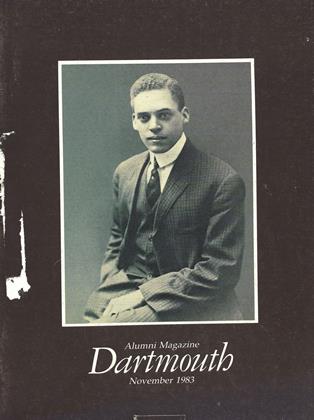During the half time ceremonies at the Cornell football game here in Hanover this fall, a group of students unfurled a large homemade Indian head banner which they proceeded to carry around the stands. A similar incident occurred three weeks later at the
Brown game, though that banner was emblazoned with a proposed alternative symbol, a timberwolf. There has been widespread controversy concerning the reappearance of the Indian symbol on windbreakers worn by students and also an incident involving several student bartenders wearing Indian head neckties at a cocktail party sponsored by the Magazine. The Cornell banner caused a spirited outporing of opinion in the Letters to the Editor section of The Dartmouth rehashing the question of what to do about the Indian symbol. In 1974, the Trustees on the recommendation of the Alumni Council deemed the use of the Indian symbol as "inconsistent with the present institutional and academic objectives of the College." Supporters and detractors alike took positions which have become familiar to anyone who has followed the controversy since it erupted most vociferously in the early '70s with the result that, as usual, no one came out the winner and the College community suffered another round of divisiveness.
Charles Wood, Daniel Webster Professor of History, commented in the October 26 edition of The Dartmouth, "because that symbol [the Indian] is a historical fact, a part of this College as late as the Dickey years, it is something which can never be taken away from older alumni." He continued, "But the Dartmouth of the 1980s is not that of the 1930s or even the 19505. Precisely because we have built on the ideals for which the old Indian symbol once stood, Dartmouth has today become much more complex, much more exciting, much more diverse. And because it has, the symbol which once used to elevate and unite now lowers and divides."
President McLaughlin issued a statement reaffirming the Trustees' original position, noting that their decision "was not an attempt to disturb or in any way be critical of generations of alumni who have in fact revered the Indian as a proud emblem of their alma mater The President concluded, "While much has changed since Doctor Wheelock's time, many of the fundamental qualities of the College have bridged the centuries and remain vitally with us today. Principal among them must always be the determination ... to respect the rights and views of others even while, perhaps, disagreeing with them. Many policies within the College including the one concerning the Indian Symbol are not matters that can be administratively legislated; they can be rendered effective only when the larger community endorses them through voluntary compliance."
 View Full Issue
View Full Issue
More From This Issue
-
 Feature
Feature"The Greatest Problem in American Biology
November 1983 -
 Feature
FeatureGiving the Rush to the Record books
November 1983 By Brad Hills '65 -
 Feature
FeatureJohn Singer Sargent: Last of the Great Portrait Painters
November 1983 By Richard Stuart Teitz -
 Sports
SportsSports
November 1983 By Kathy Slattery -
 Books
BooksAll Biology Is Indebted . . .
November 1983 By Peter Smith -
 Class Notes
Class Notes1979
November 1983 By Burr Gray
Article
-
 Article
ArticleD. C. A. Play Host
DECEMBER 1926 -
 Article
ArticleLibrary Report
December 1943 -
 Article
ArticleFor New Hampshire Boys
November 1961 -
 Article
ArticleSPRING SPORTS
APRIL 1964 By DAVE ORR '57 -
 Article
ArticleThe Friendly Arctic Revisited
OCTOBER 1962 By NORRIS W. HOWARD ’55 -
 Article
ArticleMedical School
November 1939 By Rolf C. Syvertsen M'22.

